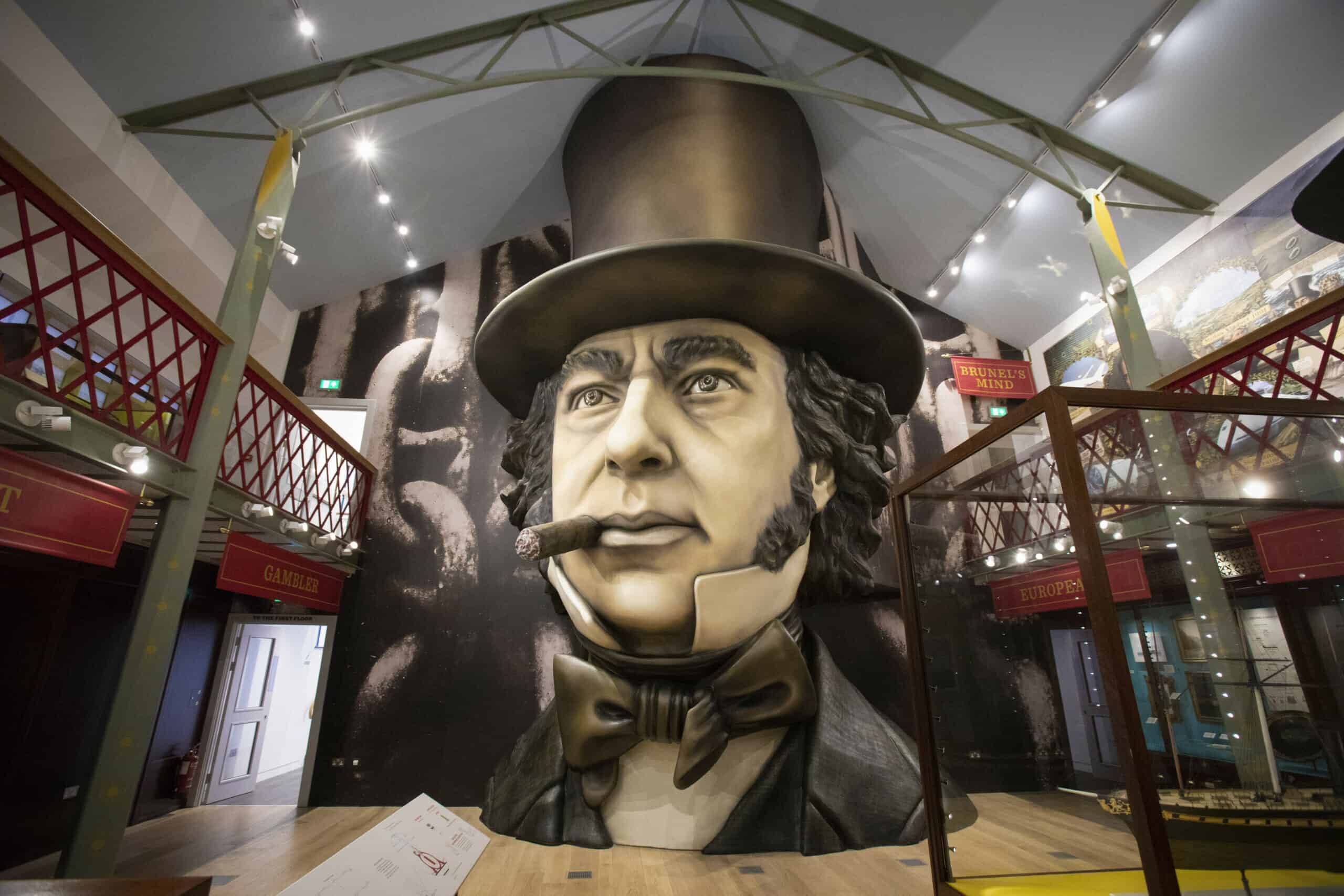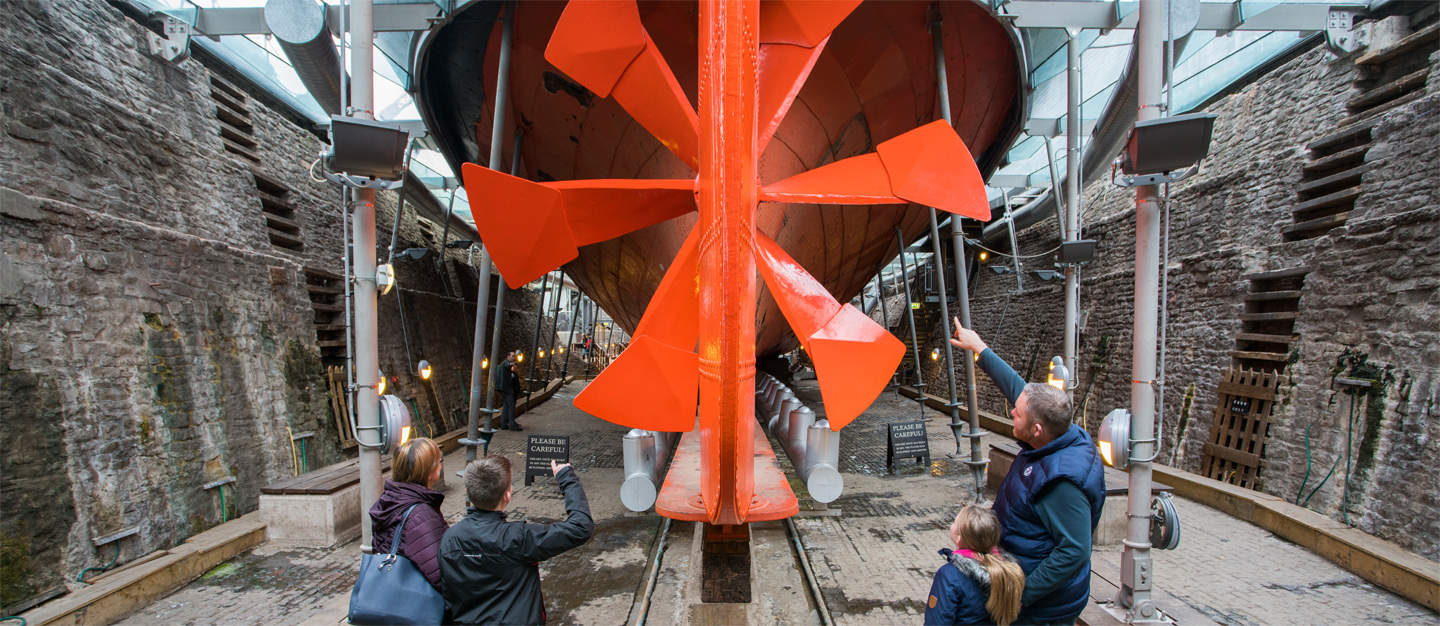The £7.2m new visitor attraction features six galleries setting out some 150 of Brunel’s personal artefacts – many never seen in public before – to provide unprecedented insight into his life, family, interests and creative mind.
Visitors can step inside Brunel’s original and fully restored Dock Office located in the historic Great Western Dockyard, where he designed and built the SS Great Britain.
Tickets can be booked online at ssgreatbritain.org and provide unlimited revisits for 12 months; £16.50 for adults with a discounted family ticket available.
The new museum exploring the life and legacy of one of engineering’s greatest minds – Isambard Kingdom Brunel – opens today. Bringing to the public for the first time the world’s most significant collection on Brunel, this museum allows visitors to discover the man who built Britain, from ocean liners like the SS Great Britain, which transformed the way we travel, to the famous Clifton Suspension Bridge.
Being Brunel is made up of six galleries housing 150 of Brunel’s personal artefacts brought together to create the most significant insight into Brunel’s influence on the world. The overall design is set to evoke the atmosphere of the Great Exhibition of 1851 – which was a celebration of Victorian wonder and invention, and featured Brunel on its design committee.
The £7.2m project on Bristol’s harbourside is located just a few metres from the SS Great Britain, the ship that revolutionised maritime engineering and world travel. The new museum incorporates the historic Great Western Steamship Company’s Dock Office, a Grade II* listed building where Brunel once worked, which has been restored as part of the project.
Visitors to Being Brunel can step into a recreation of the drawing office where Brunel and his team worked on final designs for the SS Great Britain. With tremendous attention to detail, Brunel’s office has been reconstructed based on a watercolour painted by his niece, and creates a fully immersive encounter with his environment – from its sounds and scents through to the colour of the paint based on evidence found in his original office.
The museum enables visitors to discover the man behind the extraordinary engineering talent, from his unique relationship with his father, his entrepreneurial acumen and design skill through to his love for the arts and drama. It uses key artefacts and personal possessions to unravel his astonishing story. Highlights include:
Sophia Brunel’s diary and biography of her father – the never-before-seen diary and manuscript biography of her father Sir Marc Brunel offer insights into the Brunel family’s relationships and help to highlight the great challenge at that time for women to be permitted to become engineers.
Regulator clock made by EJ Dent of London, 1841-1845 – the wall-mounted clock which hung in Brunel’s London office at 18 Duke Street has never been on public display before. Regulator clocks were extremely reliable, and Brunel used to set his watch by this one. The reliability, speed and success of his Great Western Railway, created the need for standardised timetabling across the UK, which ultimately contributed to the spread of Greenwich Mean Time across the UK.
Brunel’s cigar case and the ‘last cigar’ – this poignant object offers a glimpse into his lifestyle and his workaholic nature. It is very worn inside and out and would have been carried around during his 20-hour days all the time chain-smoking such cigars. It holds 48; a day’s supply for him.
A glimpse into his childhood – Brunel’s 1821 school report and a sketch of a horse that he drew at age six offers a rare insight into a younger Brunel, his talent and the upbringing his family gave him.
Three original paintings commissioned by Brunel depicting plays by Shakespeare – three paintings that were originally painted to be hung in Brunel’s dining room in his house on Duke Street in London will be displayed in the new exhibition. They show Brunel’s love of Shakespeare, alongside his patronage of contemporary artists. Original paintings on display will be: Jacques and the Stag, FR Lee, 1850; Macbeth and the Witches, Clarkson Stansfield, 1850; Launce’s Substitute for Proteus’s Dog, Augustus Leopold Egg, 1849.
Through in-depth analysis of his personal notebooks, as well as his ‘locked diary’, visitors will discover his dreams, ambitions and fears in a very candid way. Intriguingly, his diaries represent a contrast to the confident public image he cultivated, and show he was riddled with self-doubt, while driven to achieve success.
His professional notebooks and sketchbooks show the scale of the influence of Brunel’s work and how his innovations changed the face of the British landscape and informed future engineering; from his design of Paddington Station and the Box Tunnel through to the record-breaking size and speed of all three of his transatlantic ocean liners.
The museum uses interactive storytelling techniques to help visitors appreciate the great thinker in new ways. Exhibits include the opportunity to board a shaking 1830s broad-gauge railway carriage where ‘passengers’ will be able to compare their drawing skills to Brunel’s while travelling. Visitors can also step ‘into Brunel’s mind’ for a multi-sensory cinema experience where they can observe extraordinary moments from his life as if they were seeing it through his eyes.
Matthew Tanner, Chief Executive of the SS Great Britain Trust, said:
“By preserving Brunel’s legacy in this way, the museum aims to show what the man made, and what made the man, and we aim to inspire the innovators of the future. It will also highlight Brunel’s continuing relevance today with insight from ‘modern day Brunels’ including Norman Foster and Roma Agrawal, exploring how Brunel has inspired their work.”
Objects on display are drawn from the National Brunel Collection, housed at Brunel’s SS Great Britain in the Brunel Institute.
Being Brunel has been made possible thanks to significant support from a range of charitable trusts, foundations, individuals and companies including National Lottery Players through the Heritage Lottery Fund, Department for Digital, Culture, Media and Sport, Clive and Sylvia Richards Charity, The Wolfson Foundation, Garfield Weston Foundation, AIM Biffa Award and members of the Being Brunel Corporate Club. More information on our supporters here.
Arts, Heritage and Tourism Minister, Michael Ellis, said:
“Being Brunel is a wonderful celebration of a British engineering great and an exceptional addition to Bristol’s world-class heritage.”
“I am delighted that £5.5 million from National Lottery players and the Government has made this possible. I am sure this exhibition will serve as an inspiration to many budding engineers and be a major draw for visitors from at home and abroad.”
Nusrat Ghani, Minister for the Year of Engineering, said:
“Brunel’s legacy and the achievements of those he has inspired highlight the vital role engineering plays in shaping the world around us. But the industry faces a major challenge in encouraging young people from all backgrounds to consider careers in the profession.”
“That’s why we have joined forces with more than 1,000 partners for the Year of Engineering – a UK-wide campaign to give young people, parents and teachers direct and inspiring experiences of the creativity and innovation at the heart of engineering. I’m delighted that the SS Great Britain Trust is part of the campaign. The launch of Being Brunel is an opportunity for young people to take a closer look inside the mind of one of our greatest engineers – and to discover how their own skills and passions, from problem-solving to art and design, could see them become part of the next generation of engineers and innovators.”
Mayor of Bristol, Marvin Rees, said:
“Our cultural capital is a key element of Bristol’s appeal as a destination for visitors, job seekers and investors. I welcome the launch of Being Brunel and the contribution the new visitor attraction will make to the city’s tourism sector. Our city’s museums play an invaluable role in keeping our collective story alive and act as tools for education and exploring our own identity.”
Chief executive of VisitBritain, Sally Balcombe, said:
“Britain’s heritage is a major draw for international visitors, with Brunel’s SS Great Britain already an iconic attraction. The addition of a new museum celebrating one of the country’s greatest ever engineers will continue to put Bristol on the map globally, be a real boost for British tourism and, by driving more visitors to the region, a boost for the local economy.”





